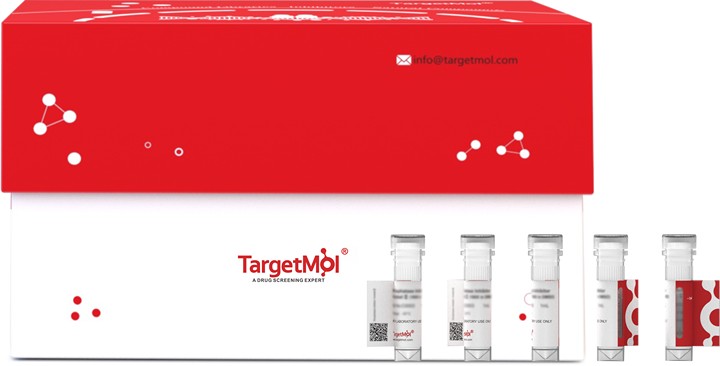 Your shopping cart is currently empty
Your shopping cart is currently empty
Coagulation Factor X Protein, Human, Recombinant (hFc)
F10, also known as Coagulation factor X, belongs to the peptidase S1 family that is synthesized as a 488 amino acid (aa) with a signal peptide and a pro region (residues 1‑40). Both the intrinsic and extrinsic pathways activate Factor X to Xa, which consists of light (residues 41‑179) and heavy (residues 235‑488) chains linked by a disulfide bond. Coagulation factor X is initially synthesized in the liver. The two chains are formed from a single-chain precursor by the excision of two Arg residues and are held together by 1 or more disulfide bonds. Forms a heterodimer with SERPINA5. F10 is a vitamin K-dependent glycoprotein that converts prothrombin to thrombin in the presence of factor Va, calcium and phospholipid during blood clotting.

Coagulation Factor X Protein, Human, Recombinant (hFc)
| Pack Size | Price | USA Warehouse | Global Warehouse | Quantity |
|---|---|---|---|---|
| 5 μg | $112 | 7-10 days | 7-10 days | |
| 10 μg | $183 | 7-10 days | 7-10 days | |
| 20 μg | $292 | 7-10 days | 7-10 days | |
| 50 μg | $545 | 7-10 days | 7-10 days | |
| 100 μg | $813 | 7-10 days | 7-10 days | |
| 200 μg | $1,190 | 7-10 days | 7-10 days | |
| 500 μg | $2,070 | 7-10 days | 7-10 days | |
| 1 mg | $2,970 | 7-10 days | 7-10 days |
Product Information
| Biological Activity | Activity has not been tested. It is theoretically active, but we cannot guarantee it. If you require protein activity, we recommend choosing the eukaryotic expression version first. |
| Description | F10, also known as Coagulation factor X, belongs to the peptidase S1 family that is synthesized as a 488 amino acid (aa) with a signal peptide and a pro region (residues 1‑40). Both the intrinsic and extrinsic pathways activate Factor X to Xa, which consists of light (residues 41‑179) and heavy (residues 235‑488) chains linked by a disulfide bond. Coagulation factor X is initially synthesized in the liver. The two chains are formed from a single-chain precursor by the excision of two Arg residues and are held together by 1 or more disulfide bonds. Forms a heterodimer with SERPINA5. F10 is a vitamin K-dependent glycoprotein that converts prothrombin to thrombin in the presence of factor Va, calcium and phospholipid during blood clotting. |
| Species | Human |
| Expression System | HEK293 Cells |
| Tag | C-hFc |
| Accession Number | P00742 |
| Synonyms | Stuart-Prower factor,Stuart factor,Coagulation factor X |
| Amino Acid | Asn32-Lys488 |
| Construction | Asn32-Lys488 |
| Protein Purity | Greater than 90% as determined by reducing SDS-PAGE. (QC verified) |
| Molecular Weight | 80-120&25 KDa (reducing condition) |
| Endotoxin | < 0.1 ng/µg (1 EU/µg) as determined by LAL test. |
| Formulation | Lyophilized from a solution filtered through a 0.22 μm filter, containing 20 mM MES, 150 mM NaCl, 0.2 mM CaCl<sub>2</sub>, pH 5.5. |
| Reconstitution | Reconstitute the lyophilized protein in distilled water. The product concentration should not be less than 100 μg/ml. Before opening, centrifuge the tube to collect powder at the bottom. After adding the reconstitution buffer, avoid vortexing or pipetting for mixing. |
| Stability & Storage | Lyophilized powders can be stably stored for over 12 months, while liquid products can be stored for 6-12 months at -80°C. For reconstituted protein solutions, the solution can be stored at -20°C to -80°C for at least 3 months. Please avoid multiple freeze-thaw cycles and store products in aliquots. |
| Shipping | In general, Lyophilized powders are shipping with blue ice. Solutions are shipping with dry ice. |
| Research Background | F10, also known as Coagulation factor X, belongs to the peptidase S1 family that is synthesized as a 488 amino acid (aa) with a signal peptide and a pro region (residues 1‑40). Both the intrinsic and extrinsic pathways activate Factor X to Xa, which consists of light (residues 41‑179) and heavy (residues 235‑488) chains linked by a disulfide bond. Coagulation factor X is initially synthesized in the liver. The two chains are formed from a single-chain precursor by the excision of two Arg residues and are held together by 1 or more disulfide bonds. Forms a heterodimer with SERPINA5. F10 is a vitamin K-dependent glycoprotein that converts prothrombin to thrombin in the presence of factor Va, calcium and phospholipid during blood clotting. |
Dose Conversion
Calculator
Tech Support
| Size | Quantity | Unit Price | Amount | Operation |
|---|

Copyright © 2015-2025 TargetMol Chemicals Inc. All Rights Reserved.



